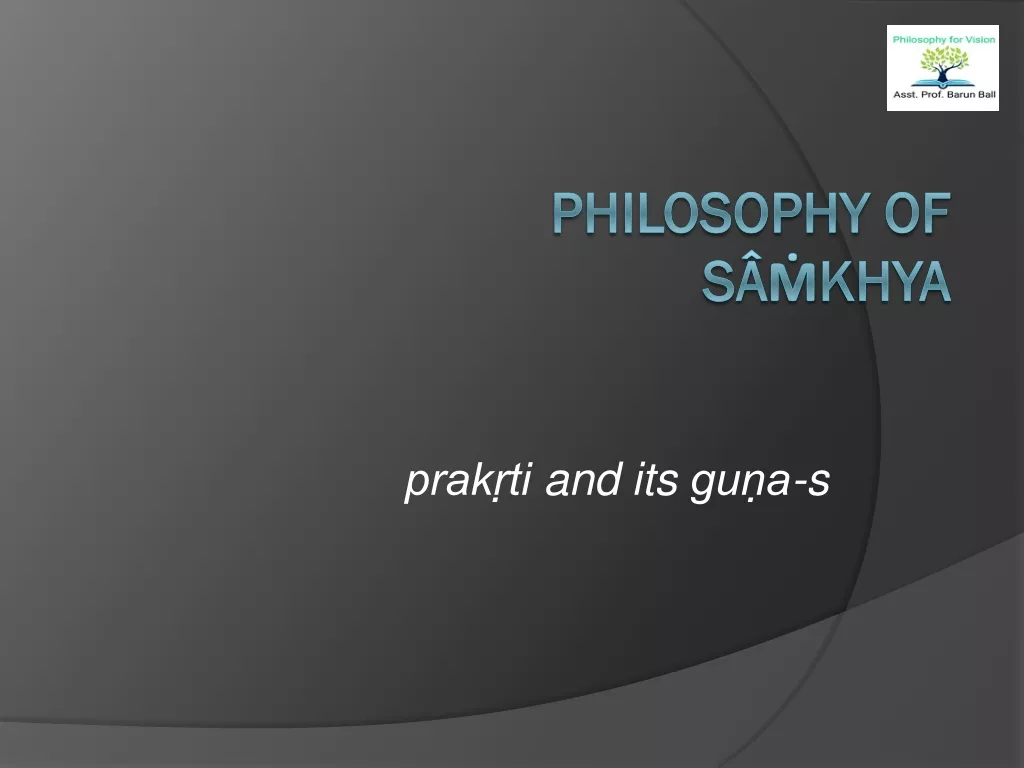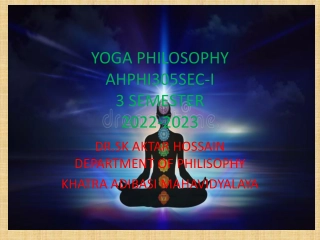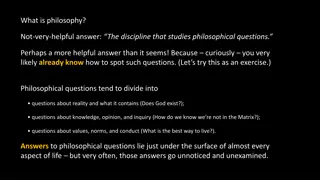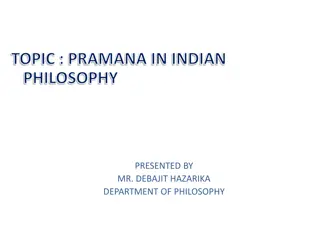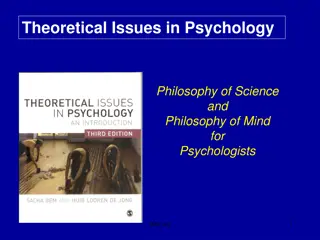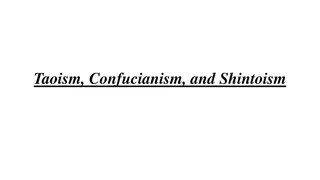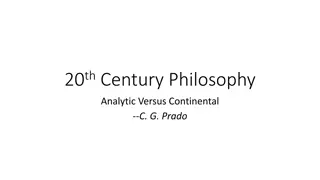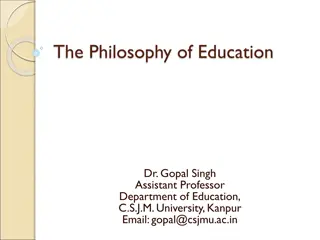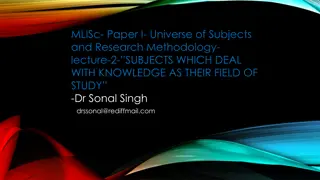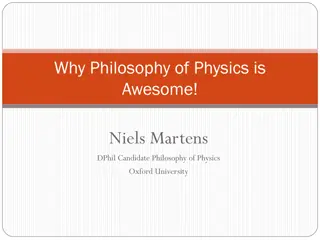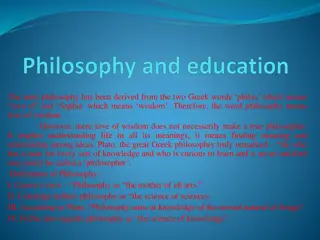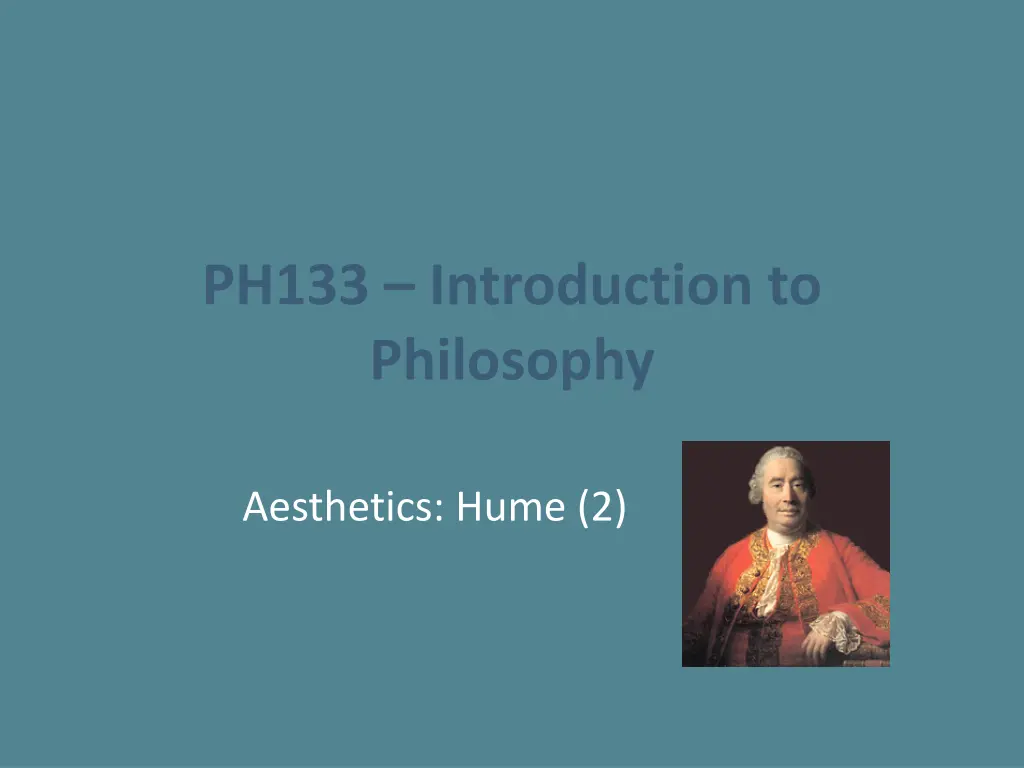
Understanding Aesthetics and Hume's Views on Art Criticism
Explore David Hume's perspective on aesthetics and art criticism through the concept of the standard of taste. Delve into questions of judgment, circularity, and the importance of true critics in appreciating art, while considering characteristics like delicacy, good sense, and lack of prejudice in evaluating artistic works.
Download Presentation

Please find below an Image/Link to download the presentation.
The content on the website is provided AS IS for your information and personal use only. It may not be sold, licensed, or shared on other websites without obtaining consent from the author. If you encounter any issues during the download, it is possible that the publisher has removed the file from their server.
You are allowed to download the files provided on this website for personal or commercial use, subject to the condition that they are used lawfully. All files are the property of their respective owners.
The content on the website is provided AS IS for your information and personal use only. It may not be sold, licensed, or shared on other websites without obtaining consent from the author.
E N D
Presentation Transcript
PH133 Introduction to Philosophy Aesthetics: Hume (2)
Standard of taste = joint verdict of true critics : Delicacy Practice Ability to compare Free of prejudice Good sense
Todays lecture Focus on issues for Hume: Do we defer judgment to others? Is Hume s view circular? Can we avoid this circularity? Why is joint verdict important? Why should we care about the taste of true critics? Hume allows us to stick with moral judgement, isn t this a form of prejudice?
Do we defer to judges? It seems that we do training as literary and artistic critics/curators. We see works of art as placing various demands on us. Hume s characteristics offer us general advice for anyone who wants to appreciate art. We can learn from the true judges to move towards greater appreciation of art.
Is his argument circular? What is good art? Good art is whatever the true judges approve of. True judges good art Who are the true judges? The true judges are the ones who pick out good art. Good art true judges How can Hume avoid such circularity?
But arent the five characteristics supposed to be objectively verifiable? How can we tell if someone possesses these 5 characteristics? It seems we must appeal to good art. Kivy But not all of these characteristics are of the same kind: some land us in a circular definition; others ... do not Practice and comparison result in circularity: Practice: the frequent survey or contemplation of a particular species of beauty Comparison: comparing the several species and degrees of excellence .
Delicacy, good sense and lack of prejudice are not circular ... Available to non-critics (non-artistic functions), and so others can judge whether a critic possesses these characteristics Aesthetic delicacy can be identified by emotional delicacy (based on his emotional reactions to non- aesthetic situations) Lack of prejudice in aesthetic case is similar to Hume s disinteresed spectator in the moral case, therefore not unique to the critic Good sense: fools seldom make good critics, clever people usually do (Kivy)
Some objections to Kivy Aesthetic delicacy identified by emotional delicacy Objection 1: emotional delicacy and aesthetic delicacy are psychologically distinct Objection 2: Fine perceiving is not sufficient for relevant delicacy, it is being able to notice certain aesthetically relevant feature But doesn t that lead back to circularity? Good sense in aesthetic judgment and rational inquiry Objection: but determining good sense is still an evaluative matter does this lead to an infinite regress?
Why do we need the joint verdict of the true judges? Why isn t one true judge enough to fix the standard of taste? There are blameless differences in taste, due to particular humours and dispositions and the manners and opinions of an age. The standard of taste exists when the true judges agree this shows that a work pleases in a way that transcends blameless local variation.
Importance of joint verdict Hume seems to argue that certain forms or qualities of objects naturally excite agreeable sentiments of beauty, or disagreeable sentiments of deformity, in human beings (Shelley), which is compatible with disagreement. We can say one perceived the relevant qualities and the other did not. (cf. Sancho s Kinsmen) Why should I care if my judgment differs from that of the true judge? What makes the standard the standard?
Importance of joint verdict Joint verdict = verdict of our perceptually better selves while everyone s taste is not equal, given the dependency of taste on the perceptual faculty, everyone s taste is equally natural, in the sense that no one ever feels an inappropriate sentiment based on the qualities perceived (Shelley, 33) The joint verdict of the true judges is the verdict each of us would give, if ... we had better perceptual abilities (Shelley, 35), in other words, it offers us the perceptual ideal.
Why should we care about the taste of ideal critics? Carroll: if the five qualities can be understood as applying to anyone, then what reason would I have to consult a group of critics? If SOT is something undiscoverable in certain people, then looks purely subjective (based in individual experience). If SOT is something discoverable in some set of experts, then it is something which, in principle, is available to all of us. Therefore, appeal to true judges is excess theoretical baggage that adds unnecessary steps to the process of aesthetic assessment ... What do I care for critics? I ll do it myself
Why should we care about the taste of ideal critics? Levinson: why should we, as non-ideal judges, care about what the ideal judges prefer? Why does it matter what things are truly beautiful, if there are things that aesthetically gratify you now, but that are, by hypothesis, not among the truly beautiful? (230) Levinson argues that they point us toward the most rewarding experiences (234) they are reliable indicators of what has the potential to give great aesthetic experience
Why should we care about the taste of ideal critics? Cohen: there is a gap between recognising that another s taste is more accurate and wanting to have that taste. A very common experience in the history of one s dealing with music or literature or painting is indeed a coming to delight in things that once failed to move one, but an attendant consequence is almost inevitably to lose the pleasure that once came from things that now seem inferior (171) Is it better to like better things?
Are our moral commitments prejudices? Why should moral value impact aesthetic value? where vicious manners are described, without being marked with the proper characters of blame and disapprobation; this must be allowed to disfigure the poem, and to be a real deformity. I cannot, nor is it proper I should, enter into such sentiments
Does moral character of a work affect its aesthetic value? Are the moral defects in a work aesthetic defects? Moral flaws in a work are aesthetic flaws: this must be allowed to disfigure the poem, and to be a real deformity Moral beliefs are not prejudices that should be set aside when engaging with a work that assumes a different moral standard.
Questions Can Hume avoid circularity/regress? Why should we care about the opinions of the true judges? Should we try to emulate the true judges? Is it better to like better art? Does Hume implicitly build in moral probity into the true judge? Does art have a role to play in revealing and correcting moral error (and if so, would Hume s conditions promote or suppress this role)? Do moral flaws always/sometimes/never count against the value of art?


